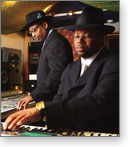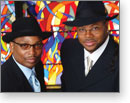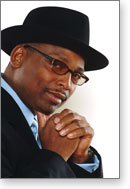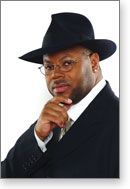|
|
Cover Story
Terry Lewis & Jimmy Jam: In Groove We Trust |
 Photos by Brett Patterson/Abrivo Studio
Photos by Brett Patterson/Abrivo Studio
It's not hard to imagine two young boys growing up in Minneapolis, smitten with
the power of music, dreaming of the big time.
It's just that Terry Lewis and James "Jimmy Jam" Harris dreamed really big.
The Twin Cities natives formed an indelible bond, and have become one of the
most influential and prolific producer/writer teams in pop music during the last
20-plus years. Look at the numbers: 16 No. 1 pop hits, more than 40 Top-10 hits,
and more than 100 albums that have reached gold, platinum and multi-platinum
status. They rank No. 2 on the list of all-time most successful producers, behind
only George Martin (The Beatles) with 23 No. 1 Billboard singles. They’re three-time
Grammy winners -- for Producer of the Year in 1986, Best R&B Song in 1993, and Best
Dance Recording in 2001 with Janet Jackson -- having been nominated a total of 14 times.
They have been nominated this year for Producer of the Year (their fourth nomination
in a row in that category), which they hope to win this month at the 46th annual
Grammy Awards.
They’ve worked with superstars like Aretha Franklin, Janet Jackson, Boyz II Men,
Mariah Carey, Patti LaBelle, P. Diddy, Usher, The Isley Brothers, Mya, Mary J.
Blige and the NBA. The list goes on and on.
Flyte Tyme Productions, just one of many companies the duo owns, has been wildly
successful, expanding from a 3,000-square-foot, two-studio office in Minneapolis
to a five-studio, 17,000-square-foot facility in Edina, Minnesota.
 It’s not hard to imagine two young boys growing up in Minneapolis, smitten with
the power of music, dreaming of the big time. It’s just that Terry Lewis and
James "Jimmy Jam" Harris dreamed really big.
It’s not hard to imagine two young boys growing up in Minneapolis, smitten with
the power of music, dreaming of the big time. It’s just that Terry Lewis and
James "Jimmy Jam" Harris dreamed really big.
They contribute money to charitable organizations such as the Thurgood
Marshall Scholarship Fund and the Flyte Tyme/UNCF Scholarship/Internship Program,
and donate their time to the National Association of Recording Arts and Sciences
and ASCAP Foundation. For the pair, it’s an empire built on a groove.
Though Lewis has moved to Malibu, and Harris owns homes in both L.A. and on Lake
Minnetonka, Minnesota, the two hold strong ties to Minneapolis. Flyte Tyme
Productions remains "bicoastal," but Edina is still home for their business,
which now includes the addition of Flyte Tyme Fylms and Flyte Tyme Advertysyng.
"We did 100 percent of our recording in Minnesota, up until the last four or
five years," Jam says.
The pair is upping its workload in Los Angeles due to increasing work in movies,
like Carey’s Glitter, How Stella Got Her Groove Back, the Cuba Gooding, Jr./BeyoncŽ
vehicle The Fighting Temptations, Radio, and the possibility of a Jeffrey
Katzenberg-animated feature this year. "At this point, I’d say we’re about 50/50,"
says Jam. "Plus," he adds with a laugh, "the airline gets a lot of business from us,
when we’re between Minneapolis and L.A."
 The duo has forged an enduring relationship that goes back to junior high in
Minneapolis. Harris, a drummer, DJ and sometime keyboard player, got his
start playing jazz and blues at the tender age of 12 with his dad in clubs
around the area. Lewis was heading for gridiron stardom at the University of
Notre Dame before an injury sidelined him permanently. A bass player, he turned
to music. The two teamed up in an adrenalized funk band called Flyte Tyme and began
building a career that would take them to the top. "It was a very diverse scene,"
says Jam, of those times. "We were playing clubs out on Lake Minnetonka, like the
Surfside, the Caribbean Club, just small clubs."
The duo has forged an enduring relationship that goes back to junior high in
Minneapolis. Harris, a drummer, DJ and sometime keyboard player, got his
start playing jazz and blues at the tender age of 12 with his dad in clubs
around the area. Lewis was heading for gridiron stardom at the University of
Notre Dame before an injury sidelined him permanently. A bass player, he turned
to music. The two teamed up in an adrenalized funk band called Flyte Tyme and began
building a career that would take them to the top. "It was a very diverse scene,"
says Jam, of those times. "We were playing clubs out on Lake Minnetonka, like the
Surfside, the Caribbean Club, just small clubs."
When some clubs decided against showcasing a black band, the two created their
own places to play, renting out hotel ballrooms and other spaces, promoting their
own shows and drawing 1,000 people on weekends. "All of a sudden," Jam says, "the
clubs were declining. We were in demand. Adversity always teaches you a lot."
In the early ’80s, their band caught the notice of another up-and-coming Minneapolis
musician and producer, Prince. He retooled the unit, changed lead singers and the
name of the group to The Time, and became their manager. "We weren’t going to get
paid a lot of money," Jam recalled in Rolling Stone, "but we were going to learn."
Jam and Lewis’ career took a turn during an Atlanta snowstorm in 1981. As part
of Prince’s touring caravan, the pair had flown to Atlanta to take advantage of
an offer from another band, S.O.S., to write and produce some songs for their
upcoming album. The snowstorm caused them to miss the Prince concert, and His
Purpleness was not pleased. Releasing the duo from the band, they quickly found
themselves as freelance producer/songwriters.
Though the pair’s official first Billboard hit was Cheryl Lynn’s "Encore," it
was the S.O.S song "Be Good To Me" that launched them on their way. It hit No. 1 in
the industry publication Radio and Record, and earned them a Top-20 placement in
Jet magazine. "I remember being really happy about it," Jam says, "but also that
we were so busy we really never took the time to stop and celebrate it. We never
did. I don’t think we thought that much of it. For us the real sign that it was a
hit was our neighbors playing it, and hearing it on car radios. That’s when we
knew."
 The two years the duo put into The Time earned them little money, but they
enjoyed a certain fame, and saw a lot of the U.S. and parts of Europe. They
knew bigger things were to come. "We were comfortable even when broke," says
Jam, "if we could make music. We took all the money that we made and reinvested
in ourselves." Rather than buying fancy cars, they bought their first little
studio, allowing them to make better music. They didn’t build houses until 10
years after that. "We thought of it as the long haul," Jam says, "and did a
handshake deal, splitting everything 50/50. We figured it would all even out.
We always had a long view of what we were doing. We didn’t want to be hot, we
wanted to be consistent over a long period of time. We figured we had a bunch
of songs in us."
The two years the duo put into The Time earned them little money, but they
enjoyed a certain fame, and saw a lot of the U.S. and parts of Europe. They
knew bigger things were to come. "We were comfortable even when broke," says
Jam, "if we could make music. We took all the money that we made and reinvested
in ourselves." Rather than buying fancy cars, they bought their first little
studio, allowing them to make better music. They didn’t build houses until 10
years after that. "We thought of it as the long haul," Jam says, "and did a
handshake deal, splitting everything 50/50. We figured it would all even out.
We always had a long view of what we were doing. We didn’t want to be hot, we
wanted to be consistent over a long period of time. We figured we had a bunch
of songs in us."
The pair opened its first studio in 1982 and launched its publishing company,
Flyte Tyme Tunes, in Minneapolis in 1984. Other ventures, including real estate,
followed. But when the pair teamed with fellow Midwesterner Janet Jackson in 1986,
their careers appeared cemented. They would produce and help co-write four of
Jackson’s best-selling recordings: Control, Rhythm Nation 1814, Janet and The Velvet
Rope, giving Jackson an aggressive, edgy sound that found favor with the
record-buying public.
The production team was in huge demand. Song by song, they were creating a
reputation for leading-edge music, and were never afraid to take chances. "The
key to our success," says Lewis, "is the love of music. Being lovers of all kinds
of music, we accept new things. Change doesn’t frighten us. And we change with
time. We’re not fad-oriented people. We’ve been fortunate to make music that
crosses color and language barriers. When you do that, you become international."
More and more, says Lewis, artists are coming to the pair because of their craft
and love of good songwriting, more so than production. Artists as diverse as R&B
heartthrob Usher, Whitney Houston, rocker Pink, gospel star Yolanda Adams,
country newcomer Rissi Palmer, Sting, Japanese pop sensation Hikaru Utada
(whose debut album sold 4 million copies in two weeks), and newcomers like Morrison
Slick and Nodesha. And then there’s what Jam calls the "special one-offs," like
creating music for the NBA All-Star Game and other NBA-related projects.
Jam adds that artists know that a Jam/Lewis production will sound like them, not
like whatever else is out there. "We’re very collaborative people," he says. "We
like to create with the artist. It’s something we can all be proud of. The way we
choose people to work with is that we have to be fans. When we walk in to buy a CD,
we know as a fan what we’d like to hear them do. We also feel like we have to be
able to do a great job, the best job, with it. Otherwise we’ll tell somebody right
away, ‘We love you, but you don’t need us.’"
Though the finished product is often a marvel of recording-technology wizardry,
the process of creating the material is largely organic. The pair employ what they
call a "vibe room," both at their facilities in Edina and in Los Angeles. It’s a
room that contains a piano, various keyboards, a drum machine, maybe a bass and
guitar, and some favorite players. Add the artist du jour and it’s an instant jam
session, one that often results in mega-platinum-selling songs.
"We start with a melody," says Lewis, "and add extras later. We have a nice little
core of musicians," including James "Big Jim" Wright and the young Avila brothers.
Jam sits at a keyboard. "Terry, if prodded, will pick up a bass," adds Jam, "but
he’s the lyric master. He’s got a notepad. If someone mentions an idea, he’s off
and running with lyrics. We vibe on stuff. We start out with conversation.
Sometimes it’s music, sometimes it’s sports, it doesn’t matter. At some point
there’s something that will spark an idea. It’s just a comfortable way to write
songs."
Among the pair’s favorite artists to work with is Mariah Carey; they helped
write and produce her multi-platinum Rainbow, the soundtrack to her motion
picture Glitter, and are now working on a new project. "She’s one of the people
who’s the most fun to do it with," says Jam. "She’s so musical. She has a million
melodies in her head, a million lyric ideas. As soon as you play a couple of
chords, she’ll march right into something. You can sit with her for a couple of
hours and maybe come up with three or four ideas, and we’ll figure out which one
is the one to focus on. But they’re all good ideas."
And a little secret about those demo/songwriting sessions: they’re all
recorded--rough, raw and in a seminal state. "They’re better than the records," Jam
says with a laugh.
"Trust me, they are!" Lewis chimes in.
How difficult is it to stay on top of the music scene, to keep the music
fresh and out front, and capture or create the beats that dominate the pop radio
airwaves? Jam used to DJ and played drums early on. "I kind of have a sense of
what rhythmically sounds good, and bad," he says. For the duo it’s instinct and
knowing what feels good. "If it moves us around here, then we hope it’ll move the
crowd at a club or on the radio."
It’s also about keeping young musicians around, like the Avila brothers. "They’re
younger guys, who are hip-hop generation guys," Jam says. "It’s important to have
young guys with perspective like that who will tell you right away, ‘That ain’t
happenin’.’ As Terry said earlier, we’re not afraid of change.
"A lot of times we’re working with an artist like Janet, where if you put a track
on, whether it’s a sample track or just drums, you know, you can tell by the way
she moves to it or the smile she gets on her face. She’s very rhythmically oriented.
If she likes it, then you know you’re on the right track."
In careers that have spanned more than two decades, Jimmy Jam and Terry Lewis
have produced scorching, trend-setting recordings, and helped shape the aural
landscape of popular music. It grew out of a love of all kinds of music, of
getting up the nerve to play that music in public, and steeling themselves for a
career in a business not known for kindness and cutting an even break.
They’ve parlayed their success into a musical empire that shows no signs of
letting up. "There’s nothing like it," says Jam. You can hear the humility in
his voice. Every day, the pair feels blessed to be able to make music the way
they feel it, in the company of world-class artists. "Blessed," he adds, "is an
understatement. It’s amazing. It’s tough to even talk about. For me, it’s not
only the fact that I’m making music. It’s that I get to do it with my best
friend."
Don Campbell is a frequent contributor to World Traveler magazine.

| |
|